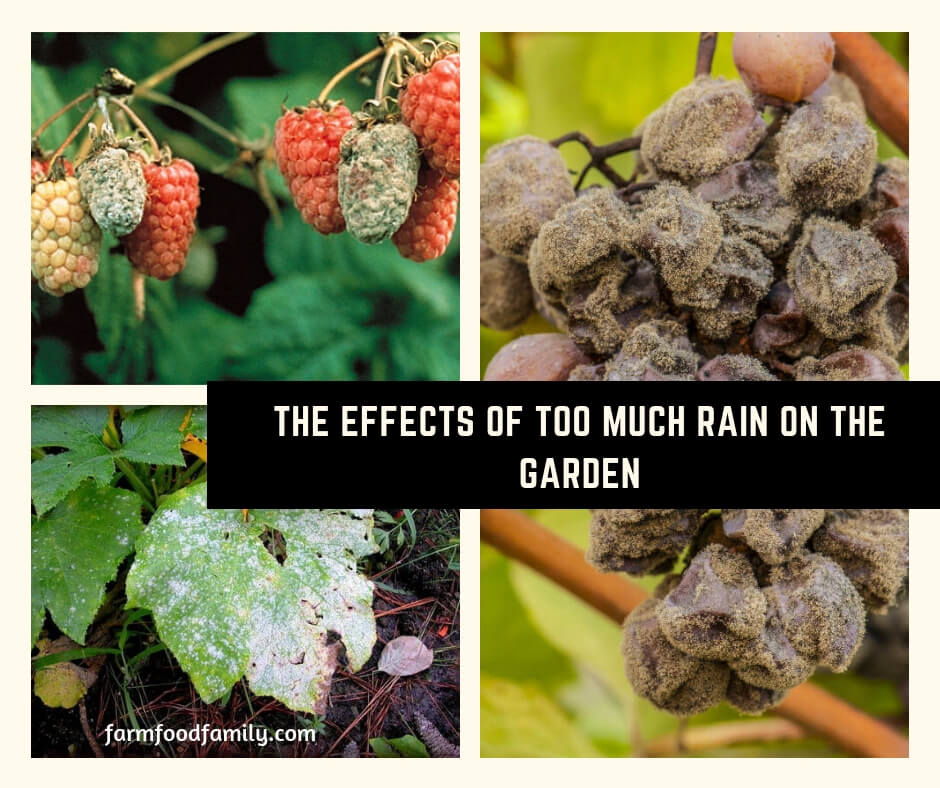Gardeners need to be aware of the negative effects of above-average rainfall on plants, and how they can prevent and treat damage to the garden.
Most gardens cannot survive without rain, but is it possible to have too much of a good thing?
While above-average rainfall can have a positive impact on drought conditions, it has negatively affected many farms and gardens, particularly this year in the United States, as seen in an increase in cases of fungal diseases and other conditions that can result in a reduced harvest.
Common Consequences of Above-Average Rainfall
Extra moisture on plants, especially if combined with increased humidity or below-average temperatures, can create a breeding ground for disease.
In some cases, the only course of action in preventing a problem from spreading is to remove and discard the plants in a sealed plastic bag. The most common diseases include the following:
Late Blight

This condition kills tomato and potato plants and has been identified this year in shipments of tomato plants to Home Depot and other big-box stores.
Signs of late blight are brown spots on the stems, leaves and eventually on the fruit. Spores can be dispersed by the wind to new plants, which can develop symptoms within about four days.
Botrytis

This gray, sometimes powdery mold affects fruits, vegetables, and ornamental plants and is the result of long periods of cool, wet weather.
It is the most common disease for strawberries, and spores in diseased plant material can remain dormant over the winter and resurface in the new growing season.
Powdery Mildew

This condition is caused by any one of over 300 related fungi, and affects mostly flowers grown in home gardens. Signs of powdery mildew are white powdery spots on the leaves, stems, and buds.
In addition to excess moisture on the leaves, warm days and cool nights as well as overcrowding of a plant species can lead to this disease. Wind and splashing rain can cause the spores to spread to neighboring plants, though depending on the fungus, different species may not be infected.
How to Protect Gardens from Damage

Gardeners should anticipate the possibility of a reduced or damaged harvest if above-average rainfall hits their area. Taking long-term forecasts in account, they can take proactive measures to control the amount of moisture their plants receive.
- Stay on top of the harvest: Although this advice is rather obvious regardless of the weather, the longer produce stays on the stalk or vine in wet, humid conditions, the more it stands the risk of infection or spoilage.
- Dig trenches to redirect water: If a certain area of the garden collects too much rain, digging a trench that is 2-3 feet deep and laying gravel and perforated pipe can solve drainage problems.
- Mound plants or build raised beds: Elevating the soil level in rows of vegetables or planting in raised beds improves drainage and helps ensure that roots don’t receive too much water.
- Add mulch: A layer of mulch will help soil stay aerated and well drained, though in cases of late blight, compost can be more effective than mulch in protecting plants.
- Keep plants off the ground and avoid overcrowding: Disease can spread and moisture can soak more quickly into leaves and fruit if they rest on wet soil for too long, and plants in close proximity to hosts and other diseased plants are also more susceptible.
- Apply fungicides: Organic fungicides as well as products containing sodium bicarbonate can be effective in preventing powdery mildew and other conditions, as long they are applied before an infestation occurs.
- Fertilize the soil: A slow-release fertilizer can help replenish nutrients that have been leached out of the soil.
Though above-average rainfall may provide gardeners with relief from watering duties, the threat of fungal diseases and other infestations should not be overlooked. With some vigilance and advanced planning, damage to plants and produce can be prevented or reduced.


